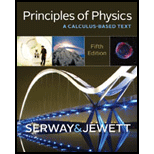
Concept explainers
(a)
The time interval during which the bicycle is ahead of the car.
(a)
Answer to Problem 38P
The time interval during which the bicycle is ahead of the car is
Explanation of Solution
Write the
Here,
Rewrite the above equation for
Use the above equation to write the expression for the time taken by the bicycle to reach its maximum speed.
Here,
It is given that the acceleration of the car is less than the acceleration of the bicycle. This implies the car cannot catch the bicycle until the time bicycle is at its maximum speed and coasting and it will be greater than the time taken by the bicycle to reach its maximum speed.
Write the equation for the total displacement of the bicycle.
Here,
It is given that the car starts from rest so that its initial velocity will be zero.
Write the equation for the displacement of the car during the time taken by the bicycle to reach the car.
Here,
When the car catches the bicycle, the two displacements will be equal.
Write the condition when the car to catches the bicycle.
Conclusion:
Substitute
Substitute
Substitute
Put equations (V) and (VI) in equation (IV).
Write the quadratic formula to solve the equation
Equation (VII) is a quadratic equation in
Since
Therefore, the time interval during which the bicycle is ahead of the car is
(b)
The maximum distance by which the bicycle leads the car.
(b)
Answer to Problem 38P
The maximum distance by which the bicycle leads the car is
Explanation of Solution
The distance by which bicycle will lead the car will increase as long as the bicycle moves faster than the car or when the speed of the car becomes equal to the maximum speed of the bicycle.
Write the equation for the elapsed time when the bicycle’s lead ceases to increase.
Here,
Write the equation for the lead of the bicycle.
Here, the subscript
Put equations (V) and (VI) in the above equation.
Conclusion:
Substitute
Substitute
Therefore, the maximum distance by which the bicycle leads the car is
Want to see more full solutions like this?
Chapter 2 Solutions
Principles of Physics: A Calculus-Based Text
- 20. Two small conducting spheres are placed on top of insulating pads. The 3.7 × 10-10 C sphere is fixed whie the 3.0 × 107 C sphere, initially at rest, is free to move. The mass of each sphere is 0.09 kg. If the spheres are initially 0.10 m apart, how fast will the sphere be moving when they are 1.5 m apart?arrow_forwardpls help on allarrow_forwardpls help on thesearrow_forward
- pls help on all asked questions kindlyarrow_forwardpls help on all asked questions kindlyarrow_forward19. Mount Everest, Earth's highest mountain above sea level, has a peak of 8849 m above sea level. Assume that sea level defines the height of Earth's surface. (re = 6.38 × 106 m, ME = 5.98 × 1024 kg, G = 6.67 × 10 -11 Nm²/kg²) a. Calculate the strength of Earth's gravitational field at a point at the peak of Mount Everest. b. What is the ratio of the strength of Earth's gravitational field at a point 644416m below the surface of the Earth to a point at the top of Mount Everest? C. A tourist watching the sunrise on top of Mount Everest observes a satellite orbiting Earth at an altitude 3580 km above his position. Determine the speed of the satellite.arrow_forward
- pls help on allarrow_forwardpls help on allarrow_forward6. As the distance between two charges decreases, the magnitude of the electric potential energy of the two-charge system: a) Always increases b) Always decreases c) Increases if the charges have the same sign, decreases if they have the opposite signs d) Increases if the charges have the opposite sign, decreases if they have the same sign 7. To analyze the motion of an elastic collision between two charged particles we use conservation of & a) Energy, Velocity b) Momentum, Force c) Mass, Momentum d) Energy, Momentum e) Kinetic Energy, Potential Energyarrow_forward
- pls help on all asked questions kindlyarrow_forwardpls help on all asked questions kindlyarrow_forward17. Two charges, one of charge +2.5 × 10-5 C and the other of charge +3.7 × 10-6 C, are 25.0 cm apart. The +2.5 × 10−5 C charge is to the left of the +3.7 × 10−6 C charge. a. Draw a diagram showing the point charges and label a point Y that is 20.0 cm to the left of the +3.7 × 10-6 C charge, on the line connecting the charges. (Field lines do not need to be drawn.) b. Calculate the net electric field at point Y.arrow_forward
 Principles of Physics: A Calculus-Based TextPhysicsISBN:9781133104261Author:Raymond A. Serway, John W. JewettPublisher:Cengage Learning
Principles of Physics: A Calculus-Based TextPhysicsISBN:9781133104261Author:Raymond A. Serway, John W. JewettPublisher:Cengage Learning College PhysicsPhysicsISBN:9781285737027Author:Raymond A. Serway, Chris VuillePublisher:Cengage Learning
College PhysicsPhysicsISBN:9781285737027Author:Raymond A. Serway, Chris VuillePublisher:Cengage Learning Glencoe Physics: Principles and Problems, Student...PhysicsISBN:9780078807213Author:Paul W. ZitzewitzPublisher:Glencoe/McGraw-Hill
Glencoe Physics: Principles and Problems, Student...PhysicsISBN:9780078807213Author:Paul W. ZitzewitzPublisher:Glencoe/McGraw-Hill College PhysicsPhysicsISBN:9781305952300Author:Raymond A. Serway, Chris VuillePublisher:Cengage Learning
College PhysicsPhysicsISBN:9781305952300Author:Raymond A. Serway, Chris VuillePublisher:Cengage Learning Physics for Scientists and Engineers, Technology ...PhysicsISBN:9781305116399Author:Raymond A. Serway, John W. JewettPublisher:Cengage Learning
Physics for Scientists and Engineers, Technology ...PhysicsISBN:9781305116399Author:Raymond A. Serway, John W. JewettPublisher:Cengage Learning University Physics Volume 1PhysicsISBN:9781938168277Author:William Moebs, Samuel J. Ling, Jeff SannyPublisher:OpenStax - Rice University
University Physics Volume 1PhysicsISBN:9781938168277Author:William Moebs, Samuel J. Ling, Jeff SannyPublisher:OpenStax - Rice University





